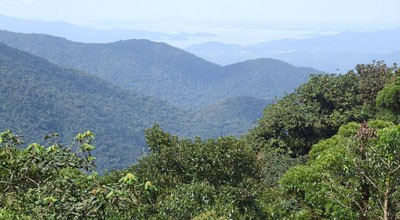A new study led by NASA and the National Center for Atmospheric Research (NCAR) shows that tropical forests may be absorbing far more human-emitted carbon dioxide than many scientists thought. The study estimates that tropical forests absorb 1.4 billion metric tons of carbon dioxide out of a total global absorption of 2.5 billion, in response to rising atmospheric levels of the greenhouse gas.
This means, if left undisturbed, the tropical trees should be able to continue reducing the rate of global warming.
“This is good news, because uptake in northern forests may already be slowing, while tropical forests may continue to take up carbon for many years,” said David Schimel of NASA’s Jet Propulsion Laboratory in Pasadena, California.
Schimel is lead author of a paper on the new research, appearing this week in the Proceedings of National Academy of Sciences.
The question of which type of forest is the bigger carbon absorber “is not just an accounting curiosity,” said NCAR scientist Britton Stephens, a co-author on the paper. “It has big implications for our understanding of whether global terrestrial ecosystems might continue to offset our carbon dioxide emissions or might begin to exacerbate climate change.”
Forests and other land vegetation currently remove up to 30 percent of human carbon dioxide emissions from the atmosphere by absorbing carbon dioxide during photosynthesis. If the rate of absorption were to slow down, the rate of global warming would speed up in return.
The new study is the first to devise a way to make apples-to-apples comparisons of carbon dioxide uptake estimates from many sources at different scales: computer models of ecosystem processes, atmospheric models used to deduce the sources of today’s concentrations (called atmospheric inverse models), satellite images, data from routine and experimental forest plots, and more. The researchers reconciled these analyses and assessed the accuracy of the inverse models based on how well they reproduced independent, airborne and ground-based measurements. They obtained their new estimate of the tropical carbon absorption from the weighted average of atmospheric, ecosystem model, and ground-based data.
“Until our analysis, no one had successfully completed a global reconciliation of information about carbon dioxide effects from the atmospheric, forestry, and modeling communities,” said coauthor Joshua Fisher of the Jet Propulsion Laboratory. “It is incredible that all these different types of independent data sources start to converge on an answer.”
The research was funded by NASA and by the National Science Foundation, which sponsors NCAR.
Growing forests, more fires
As human-caused emissions add more carbon dioxide to the atmosphere, forests worldwide are using it to grow faster, reducing the amount that stays airborne. This effect is called carbon dioxide fertilization.
But climate change also decreases water availability in some regions and makes Earth warmer, leading to more frequent droughts and larger wildfires. In the tropics, humans compound the problem by burning wood during deforestation. Fires don’t just stop carbon absorption by killing trees, they also spew huge amounts of previously-stored carbon into the atmosphere as the wood burns.
For about 25 years, most atmospheric inverse models have been showing that mid-latitude forests in the Northern Hemisphere absorb more carbon than tropical forests. That result was initially based on the then-current understanding of global air flows and limited data suggesting that deforestation was causing tropical forests to release more carbon dioxide than they were absorbing.
In the mid-2000s, Stephens used measurements of carbon dioxide made from aircraft to show that many atmospheric inverse models were not correctly representing flows of carbon dioxide in the air above ground level. Models that matched the aircraft measurements better showed more carbon absorption in the tropical forests. However, there were still not enough global data sets to validate the idea of large tropical-forest absorption.
Schimel said that their new study took advantage of a great deal of work other scientists have done since Stephens’ paper to pull together national and regional data of various kinds into robust, global data sets. He noted that the new paper reconciles results at every scale from the pores of a single leaf, where photosynthesis takes place, to the whole Earth, as air moves carbon dioxide around the globe.
“What we’ve had up till this paper was a theory of carbon dioxide fertilization based on phenomena at the microscopic scale and observations at the global scale that appeared to contradict those phenomena,” he said. “Here, at least, is a hypothesis that provides of a consistent explanation that includes both how we know photosynthesis works and what’s happening at the planetary scale.”
Atmospheric models have improved over the past decade, but there is still considerable disagreement among atmospheric inverse estimates of the distribution of carbon uptake, owing to remaining differences in modeling global air flows. “It is critical that we rigorously test these models against observations so that we can further reduce uncertainty on the terrestrial feedback to climate change,” Stephens said.

